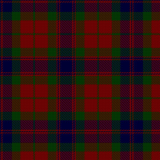Tartan of the 78th Fraser Highlanders

When one thinks of Scotland, many iconic images come to mind; rolling green hills, ancient castles, and Nessie swimming in her loch. Even more memorable than these, however, is the patterned fabric which has come to symbolize Scottish culture itself: Tartan is the only textile design in the world of which a tiny scrap can evoke such feelings of pride, such identification with the historical struggles of Scots, and identification with those desirable traits associated with being Scottish - honesty, industriousness and bravery in battle.*
Although tartan-style fabrics have a very long history – a good portion of it not Scottish – today these textiles are most famous as badges of identification. Specific colors and their arrangements function as a symbolic language in their own right, representing individuals, families and clans, as well as professional groups, companies, and organizations. To the huge international family of Scots and their descendants - estimated at 40 to 60 million around the globe - tartan represents everything that is admirable and wholesome about the land of their fathers.*
From the website of the 78th: 'The tartan worn by the Regiment has been an object of discussion throughout the years of research. Many believe that the Government Tartan (known as the Black Watch) would have been the only tartan available in large enough quantities and that it would have been the only officially endorsed pattern. Our decision to go with a simple red and green Inverness district type tartan was based on portraits and accounts, and having found a piece of this tartan in the possession of a descendent of the Regiment.'**
*http://www.tartansauthority.com/tartan/
**https://www.tartanregister.gov.uk/tartanDetails?ref=6
© Symbols.com
